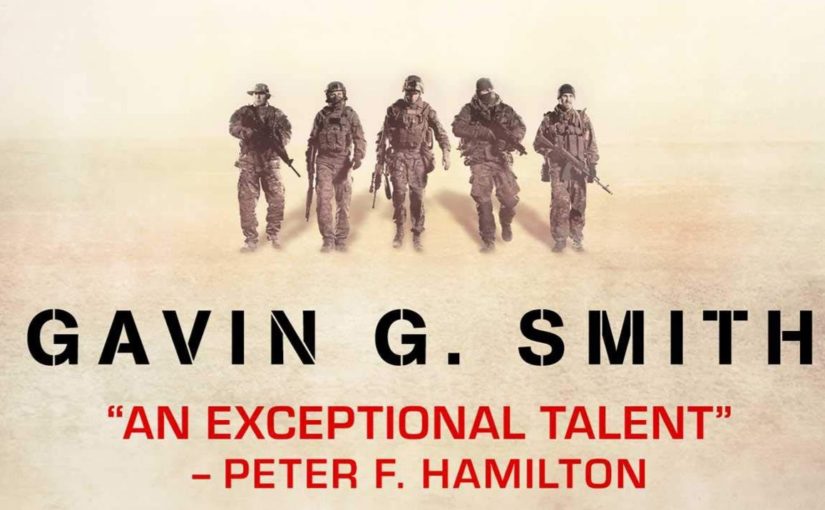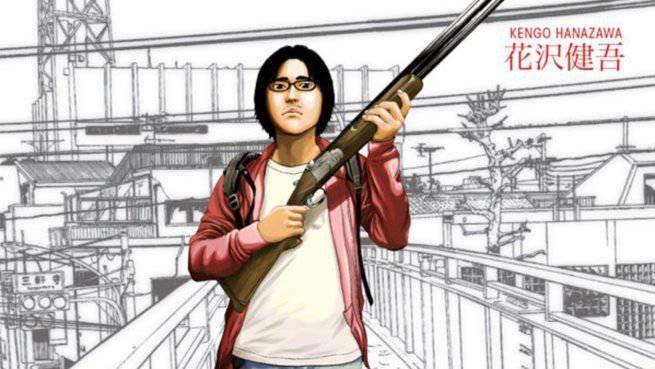I feel like every time I turn around, some nickel-plated idiot announces that the zombie genre is dead, har har. And while I don’t have a lot of time for this notion, I will grudgingly admit that we’re definitely out of the flurry of excellent zombie narratives that were published about a decade ago. Every time has its monster, and I think the zombie in the Obama years largely stood in for some pretty nasty undemocratic and racist stuff seething under the surface. I want to be clear that when I say this, I am not smearing all zombie narratives of this time period as right wing agitprop or whatever — that would be stupid and reductive.
But there are also certain inescapable through-lines to this era of zombie narrative. So many zombie narratives of the early 21st century position a white dude, often with a military or police background, and his capacity for targeted violence as the savior of domesticity and the world. World War Z (movie version), Walking Dead (both versions), Zombieland, etc. (Zombieland especially hasn’t held up so great: the character Cleveland, played by Mark Zuckerberg, ends up reading as an incel, and his murder of his hot neighbor after describing what a bitch she is for not noticing him is, as the saying goes, problematic.) It’s the old line: “You’ll be begging me to use my guns when the mob comes,” where the mob is generally coded as not-white, not-us, the ultimate dehumanized them.
Obviously, there are a lot of zombie narratives from this period which invert or subvert this trope. Take something like 28 Days Later, which turns the white military savior into anything but, the Mister Kurtz of his own sterile fiefdom. But 28 Days Later, no matter what it does with the trope, is still in dialogue with it. It’s just kind of baked into the premise: a small group end up having to organize their society balancing individual autonomy with group safety, in the most extreme environment possible. This era of the zombie narrative tended to pit the Spartan encampment against the Athenian mob, and violent expedience was the name of the game.
Since Trump’s election, Brexit, and most certainly since the Time of Covid, these tropes have become confused and messy, the coherence of the metaphor rotten. It’s just not mapping right anymore. Observe this, from a viral photo of Covid-deniers storming the Michigan capitol:
World War Q pic.twitter.com/rd5mSNR5ub
— scott linnen (@ScottLinnen) April 15, 2020
[Image description: A photo taken from inside a building looking out through windows. Several people press against the glass, most with their mouths open mid-shout. American flags, a red Trump hat, and the Guy Fawkes mask are visible. The image is captioned “World War Q”.]
Here we have a mob ostensibly fighting for personal freedom. The party of law and order tacitly condones the attack on the capitol and the murder of a policeman, if not explicitly. Authoritarianism rides to power on populism. This is ultimately what many zombie novels were presaging, but we’ve lost our taste for the fictional meat of it. I don’t know what the next monster will be, but zombies aren’t quite the zeitgeist anymore.
Which brings me rather long-windedly to Spec Ops Z by Gavin G. Smith. When I came across it in the Netgalley catalog, it struck me how long it’s been since I read a zombie novel. I think probably the last was Last Ones Left Alive, a musing, elegiac novel set in Ireland. (Oh, I also reread World War Z at the beginning of the pandemic, and that book was so accurate in its depiction of the societal and governmental responses to a global pandemic it ended up kind of hurting my feelings. ‘Sure didn’t get a laugh out of it like when I re-watched Contagion, boy howdy. ) I’ve been watching tons of zombie movies still — their low budgets all but ensure zombie movies will be cranked out forever — but the publication of zombie novels seems to be thinning.
It’s clear from the description that Spec Ops Z is more on the hardware nerd side, a kind of military sf that’s constructed like WW2 band of brothers movies starring John Wayne. In the interests of full disclosure, this isn’t particularly my bag, but I can be up for a bit of rowdy. True to form, Spec Ops Z is fast paced — except for a beginning which drags — and includes the kind of mayhem and gore I prefer in my zombie smash and grabs. The action isn’t always clearly blocked, but mostly it’s credible. Maybe most importantly, Smith doesn’t slip into pretentious philosophizing about the Nature of Man and Probably Evil Too, something I tend to find in these soldierly stories.
Spec Ops Z follows a group of Soviet Spetsnaz commandos from their posting in Afghanistan to a secret mission in NYC. It’s set in 1989 (if I remember correctly), when the Soviets were in the Afghani quagmire, not the US. (The Soviet-Afghan conflict is often called the Soviet Union’s Vietnam War, fwiw.) The members of the team all have pilot-style nicknames — Gulag, Mongol, Princess, etc — which I found somewhat precious: they were all walking around labeled with their single character trait. I couldn’t decide if this was lazy or brilliant, because it’s not like I’m reading this sort of thing for the articles, and I didn’t have to try to keep straight a dozen people with similar-sounding Russian names and patronymics. I’m leaning toward brilliant.
I was perked up at this beginning part because I actually was in the USSR in 1991, just a few months before the August coup attempt which lead to Yeltsin’s rise. Spec Ops Z appears to be a mild alt-history, in that a hard line KGB guy has deposed the reformist Gorbachev in the very recent past of the novel. As a consequence, relations are much shittier with the rest of the world. (Like, I kind of can’t imagine what might have happened if they had a hard-liner in when Reagan delivered his evil empire Star Wars nonsense. They were apparently pretty close to first striking us at that point as it was.)
The Spetsnaz team are pulled from combat in Afghanistan and sent on a secret-even-to-them mission to NY, where they set off a bioagent in Grand Central Station, one that turns everyone into zombies. Most of the team are killed, but miraculously reanimate with their reasoning intact, though the gnawing hunger to savage the living is always present. The pov character theorizes that this is because they’re all so hardened and have such great discipline and iron will from being Spetznaz soldiers. This I thought was the kind of self-aggrandizing BS a commando unit would tell themselves, so didn’t credit it overmuch. Unfortunately, later, when another character reanimates, it’s made clear this is the actual in-world reason, which, whoo boy.
The Spetsnaz are pretty pissed they ended up unwittingly bringing about the end of the world — the US retaliated with nukes, so there’s that to worry about too — and decide to go back to the USSR and revenge murder all the people involved, if they are not already shambling corpses. From then on it’s set pieces — through NY, onto a ship, etc — and largely what one expects from this sort of thing. What I really want to talk about happens in the last quarter of the novel, and therefore constitutes a spoiler according to most people. Fair warned.
SPOILERS BELOW
Like seriously I’m not kidding.
Not even a little.
When the Spetsnaz arrive in England, they come across a bunch of people dressed in Nazi uniforms. This is seriously fucking upsetting for most of the team — the leader grew up in Stalingrad during the Siege (which was fucking horrible), and others had their brushes with Nazis. It’s sometimes hard to remember now, but the USSR, the UK, and the US were all on the same side of WWII; what the hell are Nazis doing on British soil?
Turns out, these Nazis are a bunch of reenactors who started cosplaying a little too hard once the zombie apocalypse happened. They’ve set up their own little Reich in Zombieton-on-Wye, complete with a Joy Division (not just a band name) and cage matches between brown people and zombies. (I am completely tired by the zombie cage match trope, but it’s not lingered on overmuch, more’s the better.) (Also, I was fully expecting to have to grit my way through some sadistically detailed description of sexual assault, but Smith doesn’t go there, to his credit.)
I don’t think such a thing could happen in England in 1989, the scars of the War being what they were. Maybe in the States where we didn’t have to deal with the Blitz and … all the rest of it. But I legitimately don’t mean to nitpick plausibility here. For one, it’s a book about physics-defying cannibal corpses; I think I can allow a little latitude in the British national character. (Which, also, I’m not British, so.) This book was not written by someone living in 1989, and it is not being read by people in 1989 (barring time travel or whatnot.) Not even a month ago, Americans wearing the signs and emblems of both Nazis and Confederates stormed the capitol of the United States of America. Seeing Nazi cosplayers pop up in zombie fiction is pretty relevant to our times, considerably moreso when you consider that the Russians unleashed the zombie plague in both the US and UK in the book. What is zombiism but the ultimate DDOS attack?
I have occasionally been accused of overthinking pulp fiction, and it’s possible that’s what I’m doing here. However, I get the impression that Smith is really not messing around with his historical research. Much of it was spent being a total nerd about 1980s era Soviet & American weaponry — the firearms and armaments all lovingly described and detailed — but for sure he also has a detailed alt-history of the USSR. He goes so far as to name the hard-liner in charge of the country, and I suspect if my Soviet history were better, I could point to when exactly the timeline diverges. So I’ll assume Smith isn’t just writing pulp nonsense with no meaning, themes, or goals. It’s set when it is, with these specific people as protagonist, for a reason.
Given that this is a retitled reprint of a novel first published in 2017, there’s no way it’s directly addressing the Capitol Insurrection, but the rise of militant white supremacy has very much been a thing in this here age of Trumpism. But because of its placement at the very end of the novel, and the relative ease by which the ersatz Nazis are dispatched, I do kind of wonder what that sequence is trying to say. The Soviets riding in to save the British (and their America captives) from both the zombie plague they themselves unleashed AND white supremacy is also a little odd, and I’m not sure what to make of it.
I started this essay blathering about how zombies fit into a certain Obama-era ethos — before Brexit, before Trump — both anticipating and, in some cases, justifying both Trumpism and the Brexiteers. Just cut the bridges and retreat to your island in order to keep the shambling horde from overrunning those who really matter. I think Spec Ops Z ends up kinda perfectly encapsulating the ambivalent and shifting sense of meaning in zombie tropes in an America where violent white supremacy is ascendant. I’m not sure what exactly to take out of Spec Ops Z, but that could be said about every single aspect of my life at the moment: we’re all groping our ways forward.
So. An enjoyable novel with enough gory set pieces to keep me reading, and also deliberate enough to allow me to sharpen some of my favorite pet theories on it. Класс.
I got my copy from Netgalley. Spec Ops Z goes on sale February 2.






